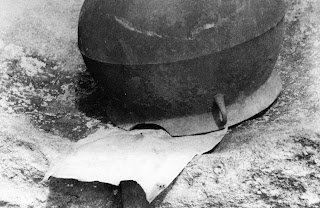One use of the design was in the extraction of pine tar from pine roots and rich sapwood. In order to accomplish that a metal pot was filled with the pine wood and upended over the petroglyph which left only the channel to the edge of the rock exposed. This channel was covered by a piece of sheet metal when possible. Any gap around the rim of the pot was then sealed with clay or mud, and a fire was built around and on top of the pot. Heat from this fire would distill the pine tar from the wood which would drip down and be caught in the channels in the rock, to run out the channel to the edge of the rock and drip down into a second container as seen below.
Sunday, April 14, 2013
"DISCOVERING SOUTH CAROLINA’S ROCK ART", BY TOMMY CHARLES:
Circle-and-line petroglyph. From: Discovering South Carolina's
Rock Art, Tommy Charles, 2010, fig. 65, p.73.
Circle-and-line petroglyph in position to process pine tar.
From: Discovering South Carolina's Rock Art,
Tommy Charles, 2010, fig. 66, p.74.
This book, published in 2010 by the University of South
Carolina Press in Columbia, includes a very interesting set of petroglyphs in
South Carolina under the stylistic designation of “circle-and-line petroglyphs.” These can best be described as a good
sized circle, deeply pecked on a horizontal rock face with a line running from
the edge of the rock to within the circle. Within the circle the line either
branches out or intersects one or more concentric circles. What I find
fascinating about these images is that they are documented to have been used by
Anglo inhabitants of the area for a couple of different household chores.
Kettle full of pine wood ready for processing. From: Discovering
South Carolina's Rock Art, Tommy Charles, 2010, fig. 68, p.76.
Set up for pine tar extraction. From: Discovering South Carolina's
Rock Art, Tommy Charles, 2010, fig. 69, p.76.
One use of the design was in the extraction of pine tar from pine roots and rich sapwood. In order to accomplish that a metal pot was filled with the pine wood and upended over the petroglyph which left only the channel to the edge of the rock exposed. This channel was covered by a piece of sheet metal when possible. Any gap around the rim of the pot was then sealed with clay or mud, and a fire was built around and on top of the pot. Heat from this fire would distill the pine tar from the wood which would drip down and be caught in the channels in the rock, to run out the channel to the edge of the rock and drip down into a second container as seen below.
Pine tar distillation runoff. From: Discovering South Carolina's
Rock Art, Tommy Charles, 2010, fig. 70, p.77.
The other purpose to which these images were turned was in
the leaching of lye from wood ashes for soap making. To accomplish this, a
container with small holes in the bottom was filled with wood ashes and set on
top of the circle and line design. Water was then poured into the top of the
container full of wood ashes and the lye leached out through the holes in the
bottom, again to be caught by the channels pecked into the rock and to run out
the main channel to the edge of the rock and drip down into a container. (Charles 2010:73-78) This lye could then be used with animal fat to make
soap, a process that I remember watching my maternal grandmother go through, although not with a
petroglyph involved.
Set up to process lye from wood ashes. From: Discovering South
Carolina's Rock Art, Tommy Charles, 2010, fig. 71, p.78.
Not all of the circle and line petroglyphs recorded in South
Carolina and reported in this book would have been usable for these processes.
Some were on vertical or angled rock faces and others on rocks that were shaped
such that it would be impractical to attempt these activities. Charles wrote: “As circle-and-line petroglyphs were
recorded in South Carolina, their individual characteristics were noted in
detail: their placement on the host rock, the size and shape of the glyph, the
configuration of the drip groove (which determined its ability or inability to
transport an extracted liquid to a container), and wear patterns created by
use. Any circle-and-line glyph that could possibly have functioned as a
tar-burner or lye-leaching stone was accepted as such. The majority of those we
recorded conform to these historic, utilitarian categories. However, there are
others whose attributes or placement eliminate them from consideration as
tar-extraction or lye-leaching rocks – or at least make them unlikely
candidates – and offer the possibility of their being prehistoric.”
(Charles 2010: 77&78)
Also, since these processes really are not used today, the
recognition of these uses of petroglyphs would seem to have depended on the
memory of elder citizens who still remember such things. Had this not been
recognized and recorded now, would people have known about it a decade or so in
the future? Would the true purpose of these images have been lost? Or would they have automatically been recorded as Native American
designs? It gives us pause to think, and to thank Mr. Charles for a great piece of detective work and for giving us
this fascinating record.
Charles, Tommy
2010 Discovering
South Carolina’s Rock Art, University of South Carolina Press, Columbia.
Labels:
lye processing,
pine tar extraction,
rock art,
South Carolina
Subscribe to:
Post Comments (Atom)










Hi,
ReplyDeletePlease let Tommy Charles I want to identify thee Hagwood Mill petroglyphs and others as well if provided photos and a publishing plan.
Regards,
Lance Carter
https://www.academia.edu/21071588/Celestial_Hagwood_Mill_Petroglyphs